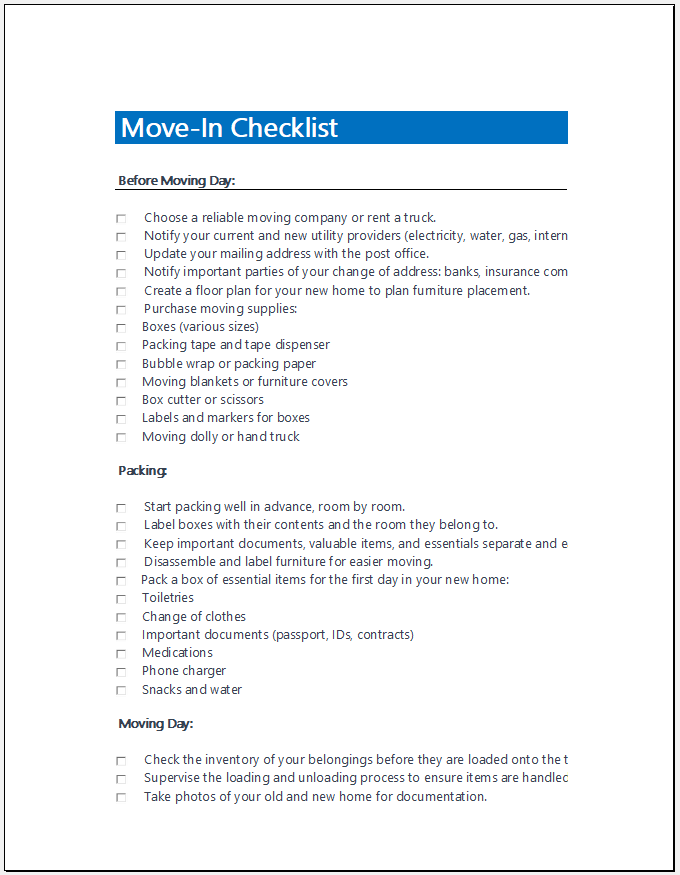Move-in Checklist Template
We prepare checklists to stay organized in our personal lives. However, we need them in our professional lives too. A move-in checklist is for tenants as well as landlords. When landlords rent out their furnished property to someone and they are supposed to use it temporarily, it is a natural urge for landlords to protect their belongings and for tenants to protect their rights.
What is a move-in checklist?
As the name suggests, this is a document that is used just before a tenant decides to move in. Once the agreement between the tenant and landlord has been signed and both are ready to be in a business relationship with each other, one of them produces this document and uses it for the security of the landlord’s belongings.
The landlord collects security deposits from the tenant, and in case of any damages caused to the contents of the property, the landlord deducts money from the security deposits. The use of the checklist ensures that both parties related to the rental property are on the same page, and they agree that the items mentioned in the checklist are available on the property and will be the center of attention at the time the tenant decides to move out.
How do I use a move-in checklist?
There are numerous ways in which this is used. In some cases, the tenant moves in, and he is given one week to walk through and make a list of everything that belongs to the landlord. Then the tenant gives this to the landlord, and he also comes and confirms if all the things mentioned in the list are present and whether there are any other items. This way, the renter and the landlord both complete the list together and review every item present on the property. This brings them together on one page, and there are very few chances for a conflict to arise.
What are the advantages of the move-in checklist?
This checklist is so important that once it is complete and has been reviewed by everyone, it is attached to the rental agreement and stays there as long as the contract remains intact. Here are a few benefits to using this document:
Documentation of the condition:
The checklist also keeps a record of the condition of the belongings present on the property. If the belongings are already damaged, the tenant can specify it in the list, and when he moves out, he will not be blamed for the damage if it has already been documented.
Similarly, items that are new need special care, and to make the tenant extra careful about using the brand new items, the checklist with the condition is shared with them. One of the biggest advantages of this checklist is that it documents the damages.
It handles disputes related to security deposits
Security deposits from the occupants of the property are refundable, and the owner of the property is required to return them as soon as the tenant moves out. The owner of the property first makes sure that his property and all the items present in it are used carefully by the tenant, and he will not have to purchase anything again, which shows that there is no loss.
Since both parties are on the same page and everything is documented, there is no dispute at the end of the business relationship.
The tenant can apply for repairs
Since the condition of the contents is documented and paid attention to by both the tenant and the landlord, they both know which item is more worn out and needs to be repaired. In other words, the tenant can simply apply for the repair of the broken items. If the owner of the items is not in a position to repair them, the tenant does not take responsibility for the broken item.
The tenant becomes extra careful
When the occupant knows that the condition and names of items are listed and documented, they become extra careful and try to take better care of those items so that their condition does not deteriorate.

Excel Template: 215 KB
- Move-in Checklist Template
- Camping Checklist Template
- Kids Screen Time Checklist
- Kids Daily Activity Checklist
- Kids Summer Activities Checklist Template
- Start of the Winter Family Checklist
- Winter Travel Checklist Template
- Home Servant Daily Chore List
- General Symptom Checklist Template
- Children Safety Checklist Template
- Sunday at-Home to-do List Template
- Maid Responsibility Sheet
- Pet Care Checklist Template
- Daily Dog Care Checklist
- Restaurant Opening & Closing Hour Checklist
← Previous Article
Camping Checklist TemplateNext Article →
Monthly Study Reminder & Planner